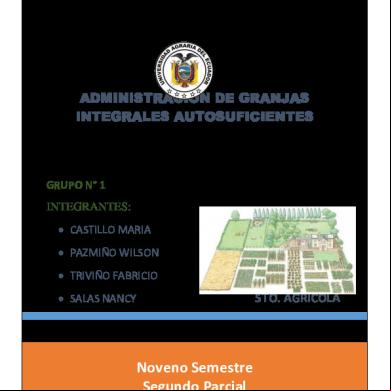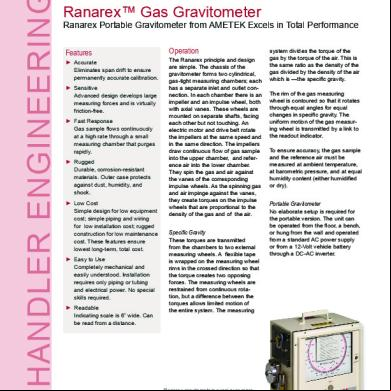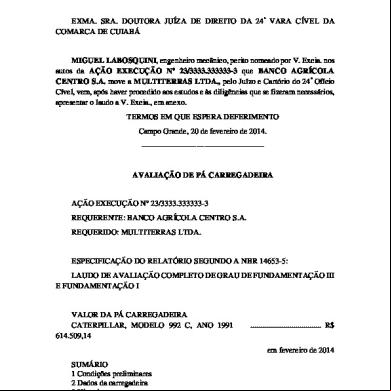Chapter-13 Assessment Gases Student Editable 2k1kb
This document was ed by and they confirmed that they have the permission to share it. If you are author or own the copyright of this book, please report to us by using this report form. Report 3i3n4
Overview 26281t
& View Chapter-13 Assessment Gases Student Editable as PDF for free.
More details 6y5l6z
- Words: 1,089
- Pages: 5
Chapter 13 Assessment: Gases Reviewing Vocabulary Match the definition in Column A with the term in Column B.
1. 2. 3. 4. 5.
6.
7. 8.
Column A Equal volumes of gases at the same temperature and pressure contain equal numbers of particles. One mole of any gas will occupy a volume of 22.4 L at STP. R represents the relationship among pressure, volume, temperature, and number of moles of gas present. Temperature, pressure, and volume are related for a fixed amount of gas. The physical behavior of an ideal gas can be expressed in of the pressure, volume, temperature, and number of moles of gas present. The pressure of a given mass of gas varies directly with the kelvin temperature when the volume remains constant. The volume of a given amount of gas held at a constant temperature varies inversely with the pressure. The volume of a given mass of gas is directly proportional to its kelvin temperature at constant pressure.
Column B a. Avogadro’s principle b. Boyle’s law c. Charles’s law d. combined gas law e. Gay-Lussac’s law f. ideal gas constant g. ideal gas law h. molar volume
Answer the following question. 9. Explain why R can have different numerical values. ______________________________________________________________________________________________ ______________________________________________________________________________________________ ______________________________________________________________________________________________
Chemistry: Matter and Change
24
Chapter Assessment
Name _____________________________________________
Date ____________________
Class ____________________
13
Understanding Main Ideas (Part A) Fill in the following table with one of these : increases, decreases, stays the same. Each term may be used more than once. Assume the amount of gas is constant. Volume
Pressure
increases
stays the same
increases
Temperature 1. stays the same
2.
stays the same
increases
3.
4.
increases
stays the same
5.
stays the same
increases
stays the same decreases decreases
increases
6. stays the same
7. stays the same
8.
stays the same
decreases
9.
increases
decreases
10.
stays the same 12.
decreases
11. stays the same
decreases
Circle the letter of the choice that best answers the question. 13.
What volume will one mole of a gas occupy under standard temperature and pressure? a. 1 L b. 22.4 L c. 273 L d. 293 L
14.
What information is NOT given by the coefficients in a balanced chemical equation? a. the mass ratios of reactants and products b. the mole ratios of reactants and products c. the ratios of number of molecules of reactants and products d. the volume ratios of gaseous reactants and products
15.
What variable is mentioned in the ideal gas law that is assumed to be constant in the other gas laws? a. number of moles b. pressure c. temperature d. volume
Chemistry: Matter and Change
25
Chapter Assessment
Name _____________________________________________
Date ____________________
Class ____________________
13
Understanding Main Ideas (Part B) Each of the following examples gives a change in volume, temperature, amount, or pressure of a gas sample. Indicate whether the other variable mentioned would increase or decrease as a result. If a variable is not mentioned, assume it is constant. 1. Additional gas is added to a soccer ball. The pressure ___________________________. 2. An inflated balloon is placed in a refrigerator. The volume _________________________. 3. A piston in an engine compresses the gas into a smaller volume. The pressure ___________________________. 4. Dry ice (solid carbon dioxide) is sealed in a plastic bag. As the temperature increases, the amount of gas present in the bag ___________________________. 5. Compressed air in scuba tanks cools off as a diver swims at deeper levels. The pressure in the tanks ___________________________. 6. The volume of an inflated balloon increases when the amount of gas in the balloon ___________________________. 7. A person sits on an air mattress. The pressure ___________________________. Solve each of the following problems. Show your work. 8. The volume and amount of gas are constant in a tire. The initial pressure and temperature are 1.82 atm and 293 K. At what temperature will the gas in the tire have a pressure of 2.35 atm?
0.0821 L atm 9. What is the volume of 2.3 mol Cl2 at 290 K and 0.89 atm? R mol K
10. An inflated balloon is left outside overnight. Initially, it has a volume of 1.74 L when the temperature is 20.2°C and the pressure is 1.02 atm. At what temperature will the balloon have a volume of 1.56 L if the pressure falls to 0.980 atm?
Chemistry: Matter and Change
26
Chapter Assessment
Name _____________________________________________
Date ____________________
Class ____________________
13
Applying Scientific Methods Elemental nitrogen (N2) makes up approximately 79 percent of the air. Nitrogen is essential to life, but plants cannot use it in its elemental form. In nature, lightning and bacteria in the soil and roots of certain plants convert atmospheric nitrogen into nitrogen-containing compounds that plants can use. However, due to the amount of agricultural crops planted, natural methods of converting atmospheric nitrogen do not provide all the nitrogen compounds needed by the growing plants. For this reason, chemical fertilizers are sprayed over the soil, supplying nitrogen compounds. Ammonia (NH3) gas is a component in the manufacturing of fertilizers. One method used to prepare the ammonia is called the Haber process. Fritz Haber first developed this process, which produces ammonia from elemental nitrogen and hydrogen gases. The following diagram summarizes the Haber process.
Chemistry: Matter and Change
27
Chapter Assessment
Name _____________________________________________
Date ____________________
Class ____________________
13
Applying Scientific Methods, continued Use what you know about gases and the Haber process to answer the following questions. Show your work. 1. Write a balanced chemical equation for the chemical reaction that occurs in the Haber process. Show the state of each reactant and product. ______________________________________________________________________________________________ 2. Heated nitrogen and hydrogen gases are reduced in volume in the compressor. What effect do these changes in temperature and volume have on the pressure of the gases? ______________________________________________________________________________________________ 3. Ammonia is a real gas. What will happen to it if the pressure continues to be increased and the temperature continues to be decreased? ______________________________________________________________________________________________ 4. What volume of ammonia gas will be produced from 2400 L of hydrogen gas at the same temperature and pressure?
5. The Haber process occurs at a pressure of approximately 800.0 atm and a temperature of 400.0°C. Assume a gas sample occupies 25.0 L at these conditions. What volume will the sample occupy at STP?
6. If 126 L of ammonia is produced at 800.0 atm and 400.0°C in the Haber process, what mass of hydrogen was used in the reaction?
Chemistry: Matter and Change
28
Chapter Assessment
1. 2. 3. 4. 5.
6.
7. 8.
Column A Equal volumes of gases at the same temperature and pressure contain equal numbers of particles. One mole of any gas will occupy a volume of 22.4 L at STP. R represents the relationship among pressure, volume, temperature, and number of moles of gas present. Temperature, pressure, and volume are related for a fixed amount of gas. The physical behavior of an ideal gas can be expressed in of the pressure, volume, temperature, and number of moles of gas present. The pressure of a given mass of gas varies directly with the kelvin temperature when the volume remains constant. The volume of a given amount of gas held at a constant temperature varies inversely with the pressure. The volume of a given mass of gas is directly proportional to its kelvin temperature at constant pressure.
Column B a. Avogadro’s principle b. Boyle’s law c. Charles’s law d. combined gas law e. Gay-Lussac’s law f. ideal gas constant g. ideal gas law h. molar volume
Answer the following question. 9. Explain why R can have different numerical values. ______________________________________________________________________________________________ ______________________________________________________________________________________________ ______________________________________________________________________________________________
Chemistry: Matter and Change
24
Chapter Assessment
Name _____________________________________________
Date ____________________
Class ____________________
13
Understanding Main Ideas (Part A) Fill in the following table with one of these : increases, decreases, stays the same. Each term may be used more than once. Assume the amount of gas is constant. Volume
Pressure
increases
stays the same
increases
Temperature 1. stays the same
2.
stays the same
increases
3.
4.
increases
stays the same
5.
stays the same
increases
stays the same decreases decreases
increases
6. stays the same
7. stays the same
8.
stays the same
decreases
9.
increases
decreases
10.
stays the same 12.
decreases
11. stays the same
decreases
Circle the letter of the choice that best answers the question. 13.
What volume will one mole of a gas occupy under standard temperature and pressure? a. 1 L b. 22.4 L c. 273 L d. 293 L
14.
What information is NOT given by the coefficients in a balanced chemical equation? a. the mass ratios of reactants and products b. the mole ratios of reactants and products c. the ratios of number of molecules of reactants and products d. the volume ratios of gaseous reactants and products
15.
What variable is mentioned in the ideal gas law that is assumed to be constant in the other gas laws? a. number of moles b. pressure c. temperature d. volume
Chemistry: Matter and Change
25
Chapter Assessment
Name _____________________________________________
Date ____________________
Class ____________________
13
Understanding Main Ideas (Part B) Each of the following examples gives a change in volume, temperature, amount, or pressure of a gas sample. Indicate whether the other variable mentioned would increase or decrease as a result. If a variable is not mentioned, assume it is constant. 1. Additional gas is added to a soccer ball. The pressure ___________________________. 2. An inflated balloon is placed in a refrigerator. The volume _________________________. 3. A piston in an engine compresses the gas into a smaller volume. The pressure ___________________________. 4. Dry ice (solid carbon dioxide) is sealed in a plastic bag. As the temperature increases, the amount of gas present in the bag ___________________________. 5. Compressed air in scuba tanks cools off as a diver swims at deeper levels. The pressure in the tanks ___________________________. 6. The volume of an inflated balloon increases when the amount of gas in the balloon ___________________________. 7. A person sits on an air mattress. The pressure ___________________________. Solve each of the following problems. Show your work. 8. The volume and amount of gas are constant in a tire. The initial pressure and temperature are 1.82 atm and 293 K. At what temperature will the gas in the tire have a pressure of 2.35 atm?
0.0821 L atm 9. What is the volume of 2.3 mol Cl2 at 290 K and 0.89 atm? R mol K
10. An inflated balloon is left outside overnight. Initially, it has a volume of 1.74 L when the temperature is 20.2°C and the pressure is 1.02 atm. At what temperature will the balloon have a volume of 1.56 L if the pressure falls to 0.980 atm?
Chemistry: Matter and Change
26
Chapter Assessment
Name _____________________________________________
Date ____________________
Class ____________________
13
Applying Scientific Methods Elemental nitrogen (N2) makes up approximately 79 percent of the air. Nitrogen is essential to life, but plants cannot use it in its elemental form. In nature, lightning and bacteria in the soil and roots of certain plants convert atmospheric nitrogen into nitrogen-containing compounds that plants can use. However, due to the amount of agricultural crops planted, natural methods of converting atmospheric nitrogen do not provide all the nitrogen compounds needed by the growing plants. For this reason, chemical fertilizers are sprayed over the soil, supplying nitrogen compounds. Ammonia (NH3) gas is a component in the manufacturing of fertilizers. One method used to prepare the ammonia is called the Haber process. Fritz Haber first developed this process, which produces ammonia from elemental nitrogen and hydrogen gases. The following diagram summarizes the Haber process.
Chemistry: Matter and Change
27
Chapter Assessment
Name _____________________________________________
Date ____________________
Class ____________________
13
Applying Scientific Methods, continued Use what you know about gases and the Haber process to answer the following questions. Show your work. 1. Write a balanced chemical equation for the chemical reaction that occurs in the Haber process. Show the state of each reactant and product. ______________________________________________________________________________________________ 2. Heated nitrogen and hydrogen gases are reduced in volume in the compressor. What effect do these changes in temperature and volume have on the pressure of the gases? ______________________________________________________________________________________________ 3. Ammonia is a real gas. What will happen to it if the pressure continues to be increased and the temperature continues to be decreased? ______________________________________________________________________________________________ 4. What volume of ammonia gas will be produced from 2400 L of hydrogen gas at the same temperature and pressure?
5. The Haber process occurs at a pressure of approximately 800.0 atm and a temperature of 400.0°C. Assume a gas sample occupies 25.0 L at these conditions. What volume will the sample occupy at STP?
6. If 126 L of ammonia is produced at 800.0 atm and 400.0°C in the Haber process, what mass of hydrogen was used in the reaction?
Chemistry: Matter and Change
28
Chapter Assessment










